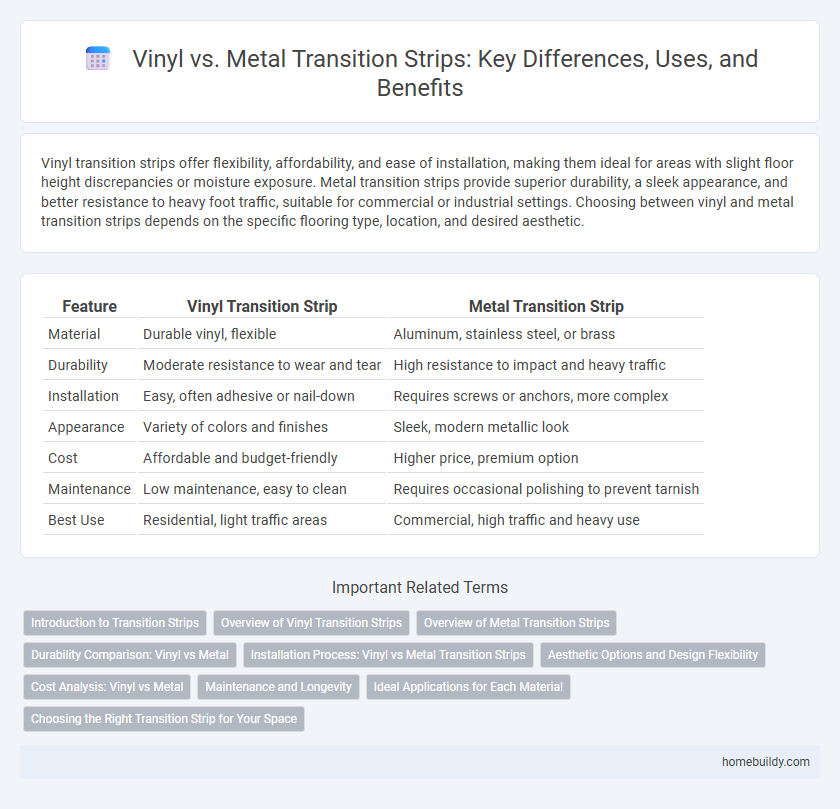Vinyl transition strips offer flexibility, affordability, and ease of installation, making them ideal for areas with slight floor height discrepancies or moisture exposure. Metal transition strips provide superior durability, a sleek appearance, and better resistance to heavy foot traffic, suitable for commercial or industrial settings. Choosing between vinyl and metal transition strips depends on the specific flooring type, location, and desired aesthetic.
Table of Comparison
| Feature | Vinyl Transition Strip | Metal Transition Strip |
|---|---|---|
| Material | Durable vinyl, flexible | Aluminum, stainless steel, or brass |
| Durability | Moderate resistance to wear and tear | High resistance to impact and heavy traffic |
| Installation | Easy, often adhesive or nail-down | Requires screws or anchors, more complex |
| Appearance | Variety of colors and finishes | Sleek, modern metallic look |
| Cost | Affordable and budget-friendly | Higher price, premium option |
| Maintenance | Low maintenance, easy to clean | Requires occasional polishing to prevent tarnish |
| Best Use | Residential, light traffic areas | Commercial, high traffic and heavy use |
Introduction to Transition Strips
Vinyl transition strips offer a flexible and cost-effective solution for joining different types of flooring, providing excellent resistance to moisture and scratches. Metal transition strips, usually made from aluminum or stainless steel, deliver superior durability and a sleek, modern aesthetic ideal for high-traffic areas. Choosing between vinyl and metal transition strips depends on factors such as flooring types, budget, and desired visual appeal.
Overview of Vinyl Transition Strips
Vinyl transition strips offer a flexible, cost-effective solution for connecting different flooring types while providing a smooth, durable surface resistant to scratches and moisture. These strips are ideal for residential and light commercial applications due to their lightweight nature and ease of installation. Their versatility in color and texture options allows seamless integration with vinyl, laminate, and carpet flooring designs.
Overview of Metal Transition Strips
Metal transition strips provide durable and sleek solutions for flooring transitions, commonly made from aluminum, stainless steel, or brass. These strips offer high resistance to wear and impact, making them ideal for high-traffic areas and commercial spaces. Metal transition strips also enhance aesthetic appeal with their modern finish while ensuring a secure and level transition between different flooring types.
Durability Comparison: Vinyl vs Metal
Vinyl transition strips offer moderate durability, resisting scratches and dents but are prone to wear over time, especially in high-traffic areas. Metal transition strips, typically made from aluminum or stainless steel, provide superior durability with excellent resistance to impact, heavy foot traffic, and environmental factors. Choosing metal ensures long-lasting protection and maintains aesthetic appeal in commercial and residential settings where durability is critical.
Installation Process: Vinyl vs Metal Transition Strips
Vinyl transition strips offer a straightforward installation process, often using adhesive backing or simple snap-in designs suitable for DIY projects, making them ideal for quick flooring transitions. Metal transition strips require precise measurements and may involve screws or nails, ensuring a durable and secure fit, which typically demands professional installation. The flexibility of vinyl allows easier adjustments during installation, whereas metal strips provide a rigid, long-lasting boundary between flooring surfaces.
Aesthetic Options and Design Flexibility
Vinyl transition strips offer a wide range of colors and textures that seamlessly blend with various flooring styles, enhancing aesthetic options for residential interiors. Metal transition strips provide sleek, modern designs with customizable finishes such as brushed nickel or matte black, offering superior design flexibility for contemporary and commercial spaces. Both materials allow tailored solutions to complement diverse decors, with vinyl prioritizing warmth and subtlety while metal emphasizes durability and minimalist appeal.
Cost Analysis: Vinyl vs Metal
Vinyl transition strips typically cost between $1 and $3 per linear foot, making them a budget-friendly option for flooring transitions. Metal transition strips, often made of aluminum or brass, range from $3 to $10 per linear foot due to their durability and premium appearance. While vinyl offers affordability and ease of installation, metal provides enhanced longevity and resistance, which may justify the higher initial investment in high-traffic areas.
Maintenance and Longevity
Vinyl transition strips require minimal maintenance due to their resistance to moisture and scratches, making them ideal for high-traffic areas. Metal transition strips offer superior durability and longevity, withstanding heavy use and providing a long-lasting barrier between flooring types. While metal strips may need occasional polishing to prevent tarnishing, their robust construction ensures extended performance compared to vinyl alternatives.
Ideal Applications for Each Material
Vinyl transition strips are ideal for residential settings and areas with light foot traffic due to their flexibility, resistance to moisture, and cost-effectiveness, making them perfect for bathrooms, kitchens, and basements. Metal transition strips, typically made from aluminum or stainless steel, suit high-traffic commercial spaces and industrial applications because of their superior durability, strength, and sleek modern appearance. Choosing between vinyl and metal depends on the environment's wear demands, moisture exposure, and aesthetic preferences.
Choosing the Right Transition Strip for Your Space
Vinyl transition strips offer flexibility, water resistance, and are ideal for areas prone to moisture, such as kitchens and bathrooms. Metal transition strips provide durability and a sleek, modern aesthetic, making them suitable for high-traffic zones like hallways and commercial spaces. Selecting the right transition strip depends on balancing factors like environmental conditions, foot traffic, and desired visual appeal.
Vinyl transition strip vs Metal transition strip Infographic

 homebuildy.com
homebuildy.com